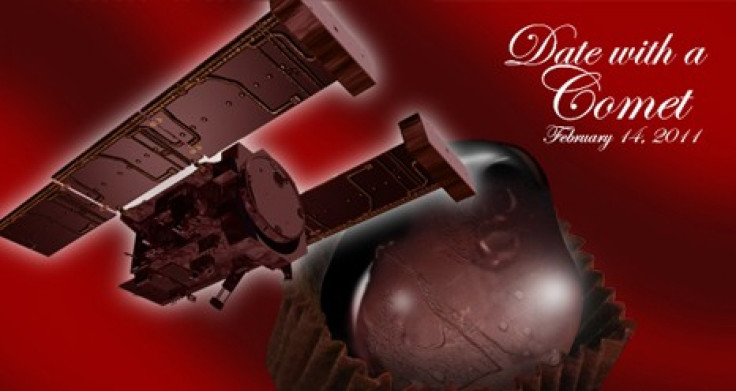NASA Spacecraft Spots Its 'Valentine' Comet

This year Valentine's Day is so special as NASA's Stardust spacecraft is preparing for final date with comet Tempel 1 on its second exploration. The world will be beginning to look at images when the spacecraft is on its closest approach to fly by comet Tempel 1 at about 11:37 pm EST on Monday, with confirmation likely to be received on Earth at about 11:56 pm EST.
This flyby of Tempel 1 will give scientists an opportunity to look for changes on the comet's surface since it was visited by NASA's Deep Impact spacecraft in July 2005. Since then, Tempel 1 has completed one orbit of the sun (every 5.5 years), and scientists are looking forward to monitoring any differences in the comet.
In addition to the images of the comet's surface, Stardust will also measure the composition, size distribution and flux of dust emitted into the coma, and provide important new information about how comets evolve.
NASA said the aging spacecraft approached 12 years of space travel on Feb. 7, logging almost 6 billion kilometers (3.5 billion miles) since launch. The spacecraft is nearly out of fuel. The Tempel 1 flyby and return of images are expected to consume the remaining fuel.
However, the spacecraft itself will no longer be active after the flyby but the data collected by the spacecraft will provide comet scientists with years of work to analyze how comets are formed and evolved.
Stardust spacecraft, which was launched on Feb. 7, 1999, became the first spacecraft in history to collect samples from Wild 2 comet, which were delivered to Earth for study. While its sample return capsule parachuted to Earth in January 2006, mission controllers were placing the still-viable spacecraft on a path that would allow NASA the opportunity to re-use the already-proven flight system if a target of opportunity presented itself.
In January 2007, NASA re-christened the mission Stardust-NExT (New Exploration of Tempel), and the Stardust team began a four-and-a-half year journey for the spacecraft to comet Tempel 1. This will be the second exploration of Tempel 1 by a spacecraft (Deep Impact). The spacecraft has traveled more than 3.5 billion miles since its launch.
Tempel 1, which is a periodic comet discovered by Wihelm Tempel in 1867, was observed in 2005 by NASA's Deep Impact mission, which put an impactor on a collision course with the comet. Stardust-NExT might get a glimpse of the crater left behind, but if not, the comet would provide scientists with previously unseen areas for study.
In addition, the Stardust-NExT encounter might reveal changes to Tempel 1 between Deep Impact and Stardust-NExT, since the comet has completed an orbit around the sun.
NASA will host several live activities for the Stardust-NExT mission's close encounter with comet Tempel 1, with live coverage beginning at 11:30 pm EST on NASA Television and the agency's website. The coverage will include live commentary from mission control at NASA's Jet Propulsion Laboratory in Pasadena, California, and video from Lockheed Martin Space System's mission support area in Denver.
Five Facts On Valentine's Day Comet
NASA listed out five facts about Stardust-NExT spacecraft as it prepares for a Valentine's date with comet Tempel 1.
-- The Way You Look Tonight - The spacecraft is on a course to fly by comet Tempel 1 at about 11:37 pm EST, on its closest approach that is significant because of the comet's rotation.
-- It's All Coming Back To Me Now – After the first mission in 2004 to collect particles and samples of interstellar dust from Wild 2 comet, the spacecraft returned the samples in 2006 via a capsule that detached from the spacecraft and parachuted to the ground at a targeted area in Utah. Mission controllers then placed the still-viable Stardust spacecraft on a flight path that could reuse the flight system, if a target of opportunity presented itself. Tempel 1 became that target of opportunity.
-- The First Time Ever I Saw Your Face – The Stardust-NExT mission will allow scientists for the first time to look for changes on a comet's surface that occurred after one orbit around the sun.
-- The Wind Beneath My Wings – This Tempel 1 flyby will write the final chapter of the spacecraft's success story. The aging spacecraft approached 12 years of space travel on Feb. 7, logging almost 6 billion kilometers (3.5 billion miles) since launch.
-- Love is Now the Stardust of Yesterday – Although the spacecraft itself will no longer be active after the flyby, the data collected by the Stardust-NExT mission will provide comet scientists with years of data to study how comets formed and evolved.
Stardust-NExT is a low-cost mission that will expand the investigation of comet Tempel 1 initiated by NASA's Deep Impact spacecraft. Jet Propulsion Laboratory, a division of the California Institute of Technology in Pasadena, manages Stardust-NExT for the NASA Science Mission Directorate, Washington, D.C.
Joe Veverka of Cornell University, Ithaca, New York, is the mission's principal investigator. Lockheed Martin Space Systems, Denver Colorado, built the spacecraft and manages day-to-day mission operations.
Comets are in unstable orbits that evolve over time on perturbations and outgassing. Tempel 1 will pass within 0.04 AU (5.9 million kilometres) of the dwarf planet Ceres on Nov. 11, 2011. Then, it will spend years interacting with the giant planet Jupiter as a Jupiter-family comet, finally passing within 0.02 AU (3 million kilometres) of Mars on Oct. 17, 2183.
© Copyright IBTimes 2024. All rights reserved.











